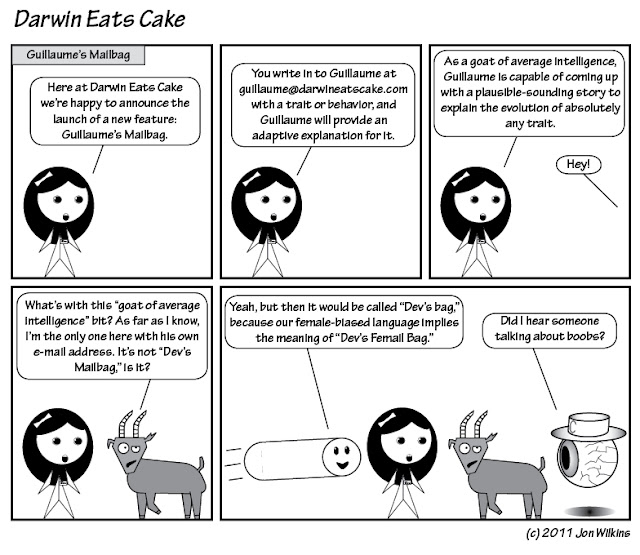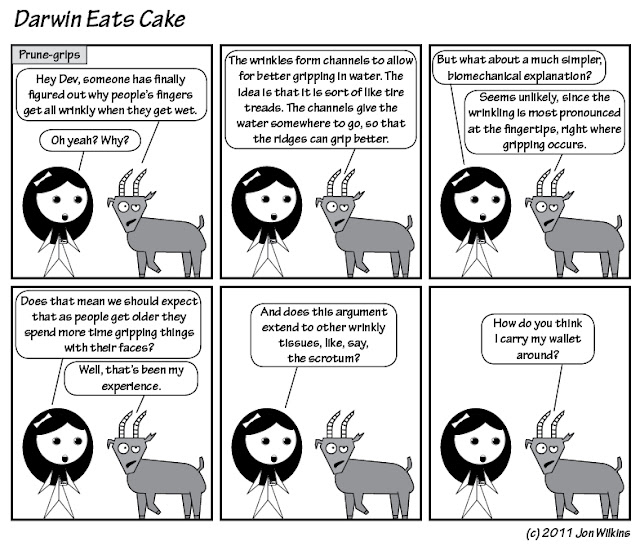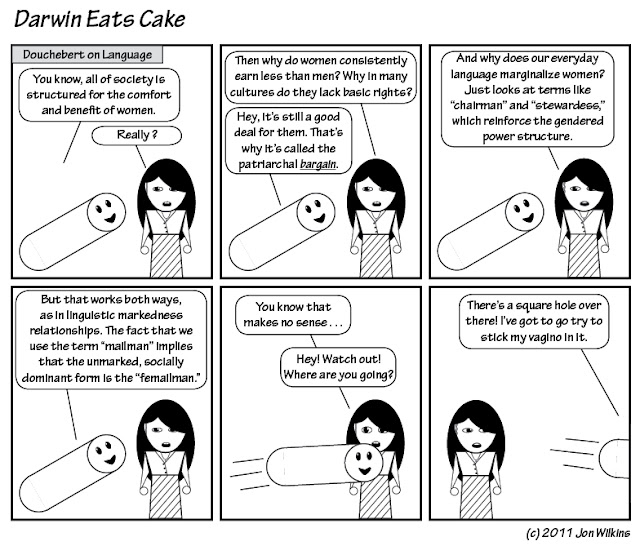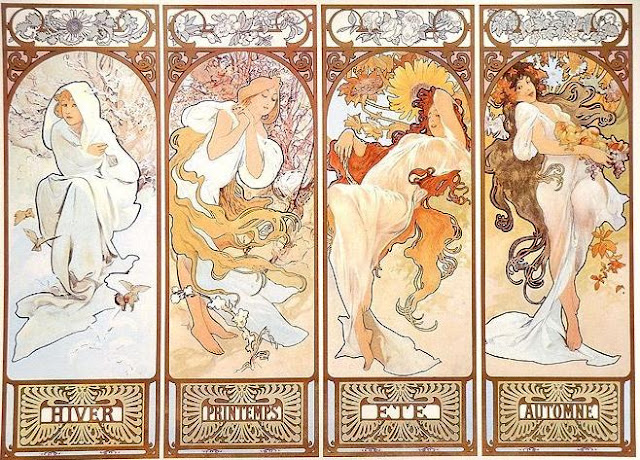So, I have no idea what is up with this, other than that William had that much hair maybe ten years ago. This is by artist Steven Vaughan, and is titled “Ordinary People, William and Kate.”
via The Superficial.
So, I have no idea what is up with this, other than that William had that much hair maybe ten years ago. This is by artist Steven Vaughan, and is titled “Ordinary People, William and Kate.”
via The Superficial.
So,
 |
| Best URL for sharing: http://www.darwineatscake.com/?id=40 Permanent image URL for hotlinking or embedding: http://www.darwineatscake.com/img/comic/40.jpg |
I’ve set up Guillaume’s e-mail: guillaume@darwineatscake.com now, and Guillaume confirms that he received the test message that my wife sent to him. You can also reach Dev, Eleonora, Brooke, Todd, iBall, Douchebert, Drillbit, and Tacey.
I can’t promise how quickly or appropriately any of them will respond, as some are much more responsible than others.
So, here’s something for anyone old enough to have played text-based games back in the day. It comes from xenuphule’s tumblr.
So, here’s the latest in adaptationism:
 |
| Best URL for sharing: http://www.darwineatscake.com/?id=39 Permanent image URL for hotlinking or embedding: http://www.darwineatscake.com/img/comic/39.jpg |
Hat-tip to Justin Blumenstiel, who is the king of transposable elements, which I think means that every time one of them transposes, they have to tithe to him.
Changizi M, Weber R, Kotecha R, & Palazzo J (2011). Are Wet-Induced Wrinkled Fingers Primate Rain Treads? Brain, behavior and evolution PMID: 21701145
So, to paraphrase Aragorn at the Black Gate, a day may come when the humor of men fails, when we lose the desire to mock Scott Adams for being a pompous jackass, but it is not this day!
Here is the third in a series (first two here and here):
 |
| Best URL for sharing http://www.darwineatscake.com/?id=38 Permanent image URL for hotlinking or embedding: http://www.darwineatscake.com/img/comic/38.jpg |
So, Farther’s day was almost a week ago, but I wanted to share this video, which illustrates all the good-timey ho-down fun that led to your father becoming your father.
Did I just call your mom a ho? It sure seems like it, doesn’t it?
If you want to try this (or something like it) at home, check out the ideas in this article:
Joseph P. Chinnici,, Joyce W. Yue,, & Kieron M. Torres (2004). Students as “Human Chromosomes” in Role-Playing Mitosis & Meiosis The American Biology Teacher, 66 (1), 35-39
So, there are a couple of things that I’m a sucker for. One is art from the Art Nouveau / Jugendstil era. The other is sequences. By sequences I mean variations on a theme – in poetry or art or music – that add a sort of texture or extra dimension to a subject.
Back around the turn of the twentieth century, Alphonse Mucha created a lot of such series, particularly of the muses and the seasons.
 |
| One of several sequences of the seasons created by Alphonse Mucha. |
Now, Mucha-style season sequences provide subject matter for a lot of artists. In a way, the allusive nature of these modern pieces adds yet another dimension to the art. Instances can be found all over the place at deviantART. For example, here’s Ariel (The Little Mermaid) as Summer, by Larocka84:
Larocka84 also has Belle (Beauty and the Beast) as Winter and Pocahontas as Autumn. I’m assuming that Spring is still in the works — maybe Chicken Little?
But most recently, I came across this series, featuring Lucius Malfoy, by artist vimessy. As the final Harry Potter movie is coming out in just a few weeks, it also seems timely:
Pure awesome. I especially love his cane. And now,when you see Malfoy on the big screen, you’re going to be imagining that, under his robes, he is wearing his Slytherin banana hammock.
So, here’s a chart published over at Tony Piro’s webcomic, Calamities of Nature. Normally it focuses on anthropomorphic animals and jokes about bacon, but religious topics also come up regularly. It’s always worth reading.
Anyway, without further comment:
So, today (June 23, 2011) marks the 99th anniversary of the birth of Alan Turing, British supergenius who played a critical role in winning World War II and is one of the founding fathers of computer science.
He was also gay, which was illegal Britain at the time. In 1952 he was prosecuted under the same law that had sent Oscar Wilde to gaol. He chose to undergo chemical castration (in the form of treatment with feminizing hormones) as an alternative to prison.
In 1954 he committed suicide in dramatic fashion. He died of cyanide poisoning, and was found lying in his bed with a half-eaten apple beside him. The speculation is that he had laced the apple with cyanide and was reenacting the apple scene from Snow White.
Turing’s earliest major contribution was the hypothetical Turing machine, which consisted of a very long piece of tape and a set of rules for manipulating the symbols on that tape. Turing showed that such a machine was, in principle, capable of performing any mathematical computation that can be represented as an algorithm. The Universal Turing Machine (a Turing machine capable of simulating any other Turing machine) provided a sort of proof-of-principle for the idea of general-purpose computers, and the tape-and-manipulator structure of the Turing machine is often cited as the prototype of the separation-of-hardware-and-software structure that pervades our computer lives today.
 |
| A Turing machine consists of a tape with symbols on it and a machine with a set of rules for reading and manipulating those symbols. And a bell. |
During World War II, Turing worked as a cryptanalyst and made major contributions to cracking the “Enigma” codes used by the German military. The success of Turing and his colleagues throughout the war gave the Allies a critical advantage, particularly during the early parts of the war, when the Germans had a significant military advantage.
After World War II, he introduced what we now call the “Turing test” for artificial intelligence. The idea is that a computer can be said to have achieved genuine intelligence if a human having a conversation with it could not tell that it was a computer. For the next forty-some years, this was considered to be the gold standard for the demonstration of human intelligence. Then came a flood of reality television, which demonstrated that many humans would not actually pass it.
During the last few years of his life, Turing turned his attention to certain problems in mathematical biology, including the curious fact that many plants seem to grow in patterns governed by the Fibonacci sequence. The whole phyto-Fibonacci thing is a weird and interesting phenomenon that will get its own dedicated post sometime soon.
In the meantime, happy birthday Alan Turing, and RIP.
Turing, A. M. (1950). Computing Machinery and Intelligence Mind, 59 (236), 433-460
So, here’s the second in what should be a short series of Darwin Eats Cake strips featuring Douchebert, the round peg who is compelled by some sort of biological determinism to attempt to insert himself into any square holes he sees.
 |
| Best URL for sharing: http://www.darwineatscake.com/?id=37 Permanent URL for hotlinking or embedding: http://www.darwineatscake.com/img/comic/37.jpg |
Before you comment, yes, I do know that Spock was fixing the warp drive, not plugging a hole in a reactor core. If it makes you feel better, think of this as a poor-taste mash-up of Star Trek II and Fukushima.